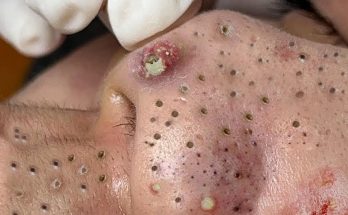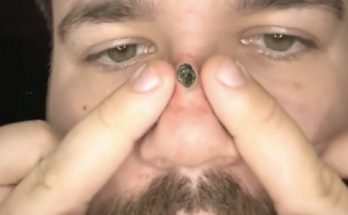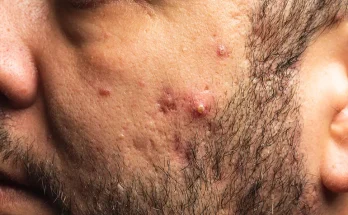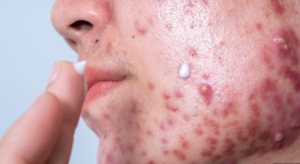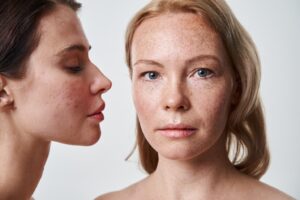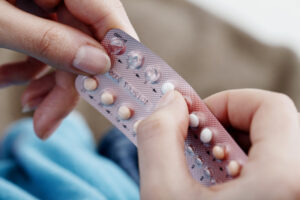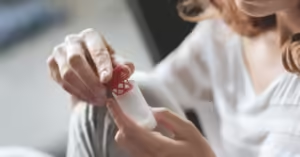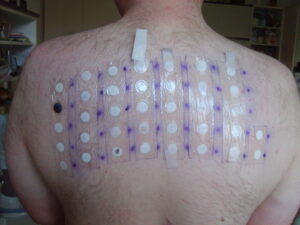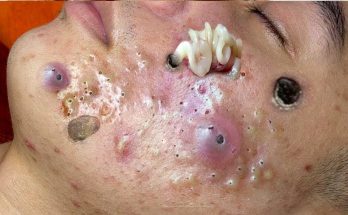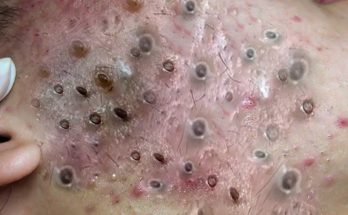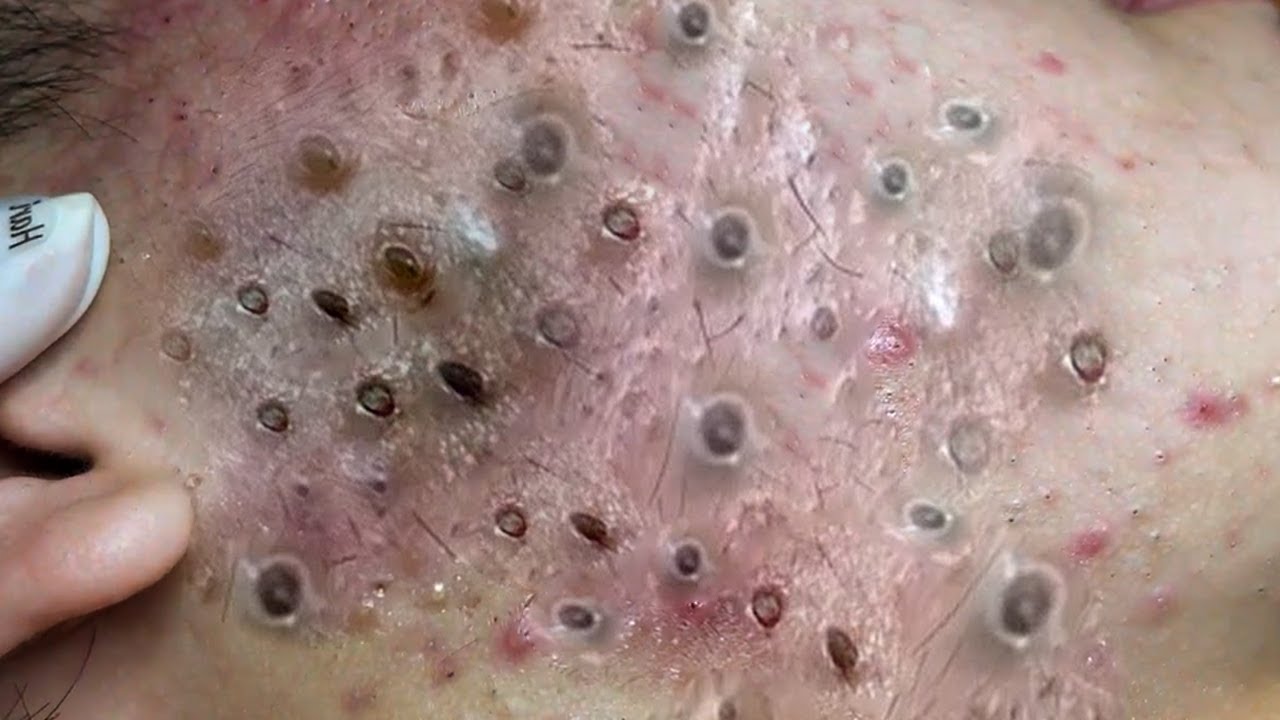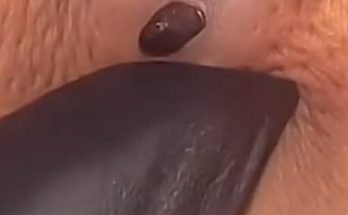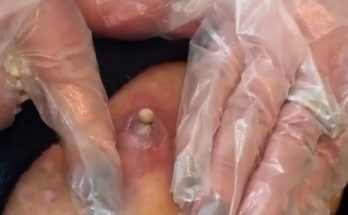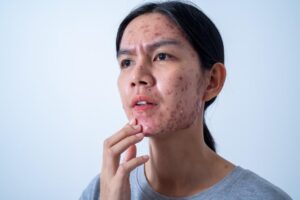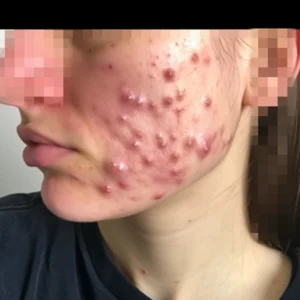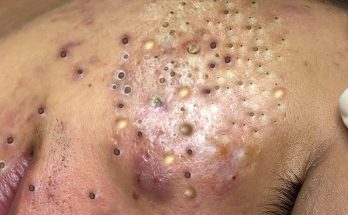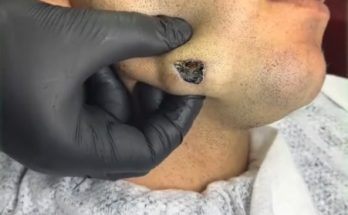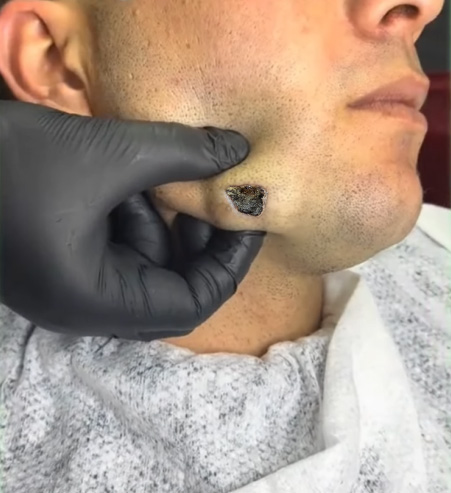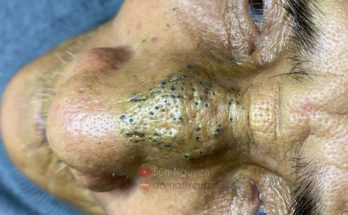What Are Blackheads?

When the plug pushes through the opening of the pore, the pore widens and becomes exposed to outside air. Once the buildup of dead skin cells and oils is exposed to the air, a chemical reaction occurs that makes the spot turn a dark color.2
Blackheads may also be referred to as open comedones.1 They are common, with the potential to affect people of various ages—from adolescents to adults.3
You might consider a blackhead a blemish to your complexion, but thankfully, they can be safely and effectively managed and prevented.3
What Do Blackheads Look Like?
Blackheads appear on the skin as tiny, dark spots. The spot is typically 1-3 millimeters in diameter and can look gray, brown, or black. Blackheads may be flat or slightly raised.34 They tend to give skin a rough texture.5
You might initially mistake blackheads for dirt. If that’s the case and you try to scrub the “dirt” away, the look of the blackheads may worsen.6
What you likely won’t see is any sign of inflammation, such as redness and swelling. Unlike other types of acne such as papules (raised red bumps) or pustules (pus-filled acne lesions), blackheads are a non-inflammatory type of acne.4
In young adolescents, blackheads are commonly found on the nose, forehead, and chin. But they can appear anywhere on the face, as well as on the chest and back.31
What Causes Blackheads?
Blackheads are formed when the skin’s pores become plugged with oil and dead skin cells.6 When these oil plugs push through the openings of pores, the pores become exposed to outside air, causing a chemical reaction that leads to blackheads.3
A blackhead is one type of comedo, or acne bump. Comedones can be open or closed, based on whether the skin surface is disrupted. Since blackheads disrupt the skin surface, they are referred to as open comedones. A comedo that has it surface in tact is called a closed comedo, or a whitehead.5 Blackheads can form if whiteheads open up the pores.4
You might be more likely to get acne like blackheads if your parents had acne. You might also be more prone to blackheads and other types of acne if you have oiler skin. This can happen if you experience hormonal changes from factors like puberty or stress. Using greasy cosmetic and hair products, sweating a lot, and excessively touching your skin can also make your skin oiler.7
How To Get Rid of Blackheads
First, don’t touch, pop, or squeeze blackheads. This can worsen acne, cause an infection, or lead to permanent scarring.26
While they can be a nuisance to deal with, there are steps you can take to eliminate blackheads.6 This includes several at-home treatment options. You can also visit a healthcare provider such as a dermatologist—a medical doctor who specializes in conditions affecting the skin, hair, and nails—for additional treatment options.8
Safe, effective blackhead treatments include:
Face Wash With Acne-Fighting Ingredients
To get rid of blackheads, start by washing your face twice daily with a medicated face wash formulated to treat acne. Look for a face wash containing benzoyl peroxide or salicylic acid.6 Benzoyl peroxide eliminates excess acne-causing bacteria, and salicylic acid unclogs blocked pores.69
Topical Acne Treatments
There are several acne treatments available over-the-counter (OTC) or by prescription that can help get rid of blackheads when applied directly to the skin once or twice per day. These include benzoyl peroxide (Benzoyl), azelaic acid (Finacea), and retinoids, which have all been shown to be effective at treating and preventing blackheads.10
Both benzoyl peroxide and azelaic acid kill acne-causing bacteria, while azelaic acid decreases excess production of keratin, a natural substance that can lead to acne when produced in excess.11
Prescription retinoids—skincare products derived from vitamin A—such as tretinoin cream, can help reduce oiliness, unclog pores, and increase skin cell turnover.6
Some treatments also include sulfur, which can break down blackheads.
These topical treatments can come in a variety of forms, including gels, lotions, creams, soaps, and pads.12
Extractions
Blackhead extraction is a manual method of removing blackheads. It is performed in a dermatologist’s office. When performed correctly, the extraction is a safe treatment that does not leave any scarring. Extractions are usually only recommended if OTC treatments have not been effective.13
During the procedure, the skin is lightly pierced with a needle or a surgical blade. Next, a comedone extractor is applied with light-to-medium pressure on top of the blackhead until the tool removes all the clogged dead skin cells and debris.13
Chemical Peels
Performed by a dermatologist, chemical peels are another in-office treatment. The procedure removes the skin’s outer layer to resurface the skin and enhance collagen production. The treatment uses high concentrations of beta-hydroxy acids like salicylic acid.13
While chemical peels are generally well-tolerated, there can be side effects such as mild discomfort, redness, irritation, or post-inflammatory lightening or darkening of skin following treatment.14
Because there are more mild acne treatments people can try first, chemical peels are considered a complementary treatment and are not often used as an initial treatment option for blackheads and other types of comedones.13
Editor’s Note: While some in-office treatments can pose risks like scarring or infection if performed improperly, the risks are greatly minimized if you see a board-certified dermatologist for diagnosis and treatment. These doctors have training and experience in skincare treatments and procedures, so they can properly assess your skin and determine the right treatment for your blackheads.8
How To Prevent Blackheads
To prevent blackheads from occurring or returning, there are a number of tips you can implement into your everyday routine at home. You can prevent blackheads by doing the following:615
Gently cleanse your skin regularly: Wash your face after sweating and up to two times per day. Use a gentle cleanser, and apply the cleanser with your fingertips. Avoid harsh scrubbing with washcloths, sponges, or other cleaning tools that can irritate the skin.
Shampoo your hair regularly: An excess of natural hair oils can cause acne on your forehead. To prevent this, shampoo your hair more often and tie your hair away from your face to help prevent blackheads and other types of acne from forming.
Use non-comedogenic skincare: Opt for skincare products that are labeled as “non-comedogenic.” This designation means these products are free of pore-clogging ingredients that can lead to acne.
Give your treatment time to work: Acne treatments need six to eight weeks to make a difference. Be patient and stay the course. If you don’t see improvement after this period of time, schedule an appointment with a dermatologist. A dermatologist can recommend or prescribe other treatments, such as prescription-strength acne medication or extractions and microdermabrasion, if at-home treatments aren’t effective.
Keep your hands off your face: Don’t pop, pick, or squeeze your acne. Touching blackheads can worsen existing acne and extend the time it takes for them to heal. Squeezing acne can cause scarring, infection, or dark spots called post-inflammatory hyperpigmentation.
Be sun-safe: Use sunscreen or wear a hat when outside. It’s also advisable to avoid tanning beds, which can worsen acne. Some acne medications can also make the skin extra sensitive to skin-damaging ultraviolet rays from the sun and tanning beds.
A Quick Review
A blackhead is a small, tiny dark spot that forms on the skin when a pore become clogged with excess oils and dead skin cells. A blackhead appears dark—either gray, brown, or black—because of a chemical reaction that happens when the buildup of oil and dead skin cells pushes through the opening of a pore and is exposed to the air. Blackheads are more commonly seen on the face, chest, and back.
There are a number of methods you can use to treat blackheads, including medicated acne face washes and topical acne treatments such as retinoids and benzoyl peroxide. If you are having trouble getting rid of blackheads at home, schedule an appointment with a dermatologist to discuss additional treatment options, such as a procedure like an extraction.
Blackheads can be a bother. Fortunately, there are some simple practices you can try at home to prevent blackheads from appearing in the first place, such as keeping your hands and hair off your face and cleaning your skin regularly.
